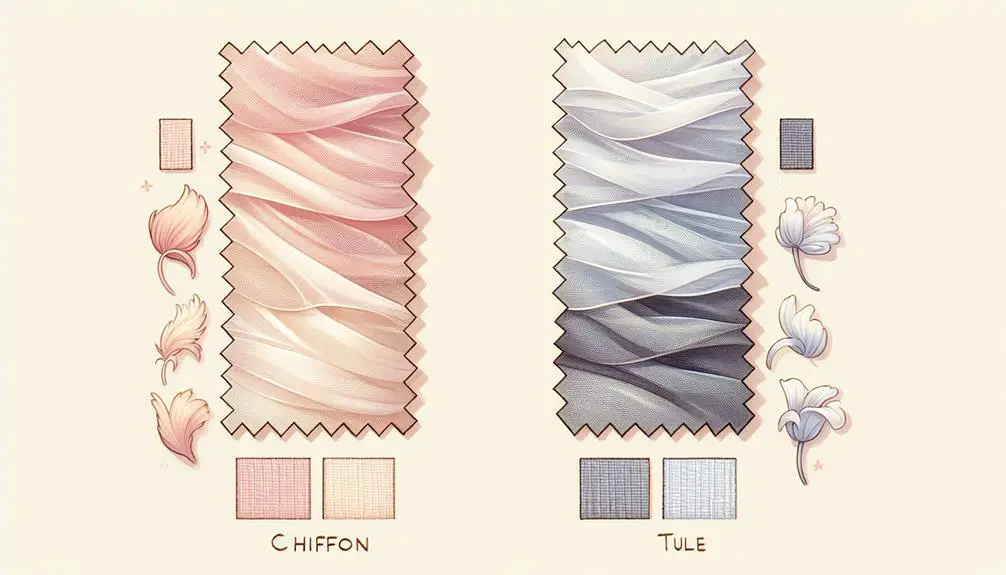As the saying goes, 'The devil is in the details,' and this couldn't be more true when it comes to understanding the nuances between chiffon and tulle.
While both fabrics are delicate and often used in elegant designs, their disparities lie in their composition, weaving techniques, and draping qualities.
So, before making your next fabric choice for that special occasion or DIY project, it is crucial to grasp the distinctions between chiffon and tulle to make sure your creation turns out just right.
Table of Contents
Key Takeaways
- Chiffon is sheer with a smooth texture, while tulle is net-like and airy.
- Chiffon uses a plain weave, tulle has a hexagonal weave for sheerness.
- Chiffon feels soft, tulle is lightweight to touch.
- Color appearance varies with dyeing and sheen, impacting design choices.
Composition of Chiffon and Tulle
When it comes to the composition of chiffon and tulle, these two delicate fabrics differ greatly regarding their material makeup and texture. Chiffon is crafted from fibers like silk, cotton, polyester, or rayon. These fibers give chiffon a lightweight and sheer quality, making it a popular choice for elegant dresses and flowing scarves.
On the other hand, tulle is typically made from silk, nylon, or rayon fibers. The key difference lies regarding the weaving techniques used for each fabric. Chiffon tends to have a more tightly woven structure compared to tulle, resulting in a smoother and more lustrous appearance.
Regarding fabric weight, chiffon is lighter than tulle, which is often used in layers to add volume and structure to garments like ballerina skirts and bridal gowns. Understanding these fiber variances and fabric weights can help you choose the right material for your next project with confidence.
Weaving Techniques Used
In exploring the distinctions between chiffon and tulle, it's essential to keep in mind the weaving techniques employed in crafting these delicate fabrics. When it comes to fabric construction, chiffon is typically made using tightly twisted yarns in a plain weave, giving it a soft and slightly bumpy texture. On the other hand, tulle is crafted using a hexagonal weave pattern, creating a net-like structure that's lightweight and sheer.
Let's dive deeper into the weaving techniques used in crafting chiffon and tulle:
- Fabric Construction:
- Chiffon is woven using tightly twisted yarns in a plain weave pattern.
- Tulle is crafted using a hexagonal weave pattern, creating a net-like structure.
- Sheerness Levels:
- Chiffon tends to have a more opaque appearance due to its tighter weave.
- Tulle, with its open hexagonal weave, is extremely sheer and lightweight, perfect for layering in garments.
Understanding the intricate weaving techniques behind chiffon and tulle provides insight into their unique characteristics and uses in the world of fashion and design.
Transparency and Opacity Levels
Understanding the transparency and opacity levels of chiffon and tulle is essential in grasping their distinctive characteristics in fabric construction. Chiffon is known for its sheer and lightweight quality, allowing light to filter through the fabric beautifully. On the other hand, tulle can vary in opacity depending on the number of layers or the tightness of the weave.
To better illustrate the differences in sheerness levels and opacity between chiffon and tulle, let's compare them in a table:
| Fabric | Sheerness Levels | Opacity |
|---|---|---|
| Chiffon | Very sheer | Low |
| Tulle | Sheer to opaque | Variable |
Chiffon, with its delicate and translucent nature, is perfect for creating ethereal and flowing garments, while tulle offers a range of opacity levels suitable for creating structured or voluminous designs. Understanding these characteristics will help you choose the right fabric for your desired look.
Texture and Feel Differences
Feeling the fabrics between my fingers, I notice that chiffon and tulle differ greatly in their texture and overall feel.
- Chiffon: When I touch chiffon, it feels incredibly smooth and silky. The fabric is soft against the skin, giving a delicate sensation that exudes elegance and sophistication.
- Tulle: On the other hand, tulle feels airy and lightweight. Its texture is more structured compared to chiffon, yet it maintains a softness that's gentle to the touch. Tulle provides a dreamy and ethereal feel when handled.
- Comparison: While chiffon offers a luxurious and flowing texture that drapes beautifully, tulle has a more voluminous and structured feel, making it ideal for creating volume and adding a touch of whimsy to any garment or decor.
Color Variations in Fabrics
Exploring the various color variations in fabrics reveals a spectrum of hues that can evoke different moods and styles. When it comes to dyeing techniques, fabrics like chiffon and tulle offer a wide array of possibilities. Each fabric pattern takes on dye uniquely, resulting in distinct color outcomes. Additionally, fabric weight influences how colors appear – lighter fabrics often showcase hues in a more ethereal manner compared to heavier fabrics that may intensify colors. Furthermore, fabric sheen plays an important role in color variations. Fabrics with a glossy sheen like chiffon can reflect light differently, giving colors a luminous quality, while tulle with a matte sheen may offer a more muted color appearance.
| Dyeing Techniques | Fabric Patterns | Fabric Weight |
|---|---|---|
| Unique outcomes | Varied designs | Light vs. Heavy |
| Varied possibilities | Distinct appearances | Color intensity |
Understanding these nuances in color variations can help in selecting the perfect fabric for a desired look.
Draping and Wrinkling Characteristics
As we admire the color variations in fabrics, let's now observe how chiffon and tulle showcase distinct draping and wrinkling characteristics.
- Fabric Drape: Chiffon drapes beautifully due to its lightweight and floaty nature, creating an elegant and flowing look when used in garments. On the other hand, tulle has a more structured drape, giving volume to skirts and dresses with a touch of stiffness.
- Wrinkle Resistance: Chiffon tends to wrinkle easily, requiring careful handling and maintenance to keep it looking pristine. In contrast, tulle is more wrinkle-resistant, making it a preferred choice for garments or decor that need to maintain a crisp appearance over time.
- Sheerness Levels and Texture Comparison: Chiffon is sheer and delicate, adding a romantic and ethereal quality to designs. Tulle, while also sheer, has a stiffer texture that lends itself well to creating volume and structure in garments like ballerina skirts or veils.
Versatility in Fashion and Decor
In fashion and decor, chiffon and tulle offer a diverse range of possibilities due to their unique characteristics and textures. Chiffon's delicate and flowing nature makes it a favorite for elegant evening gowns, while tulle's lightweight and airy quality lends itself well to whimsical bridal veils and ballerina skirts. Let's explore how these fabrics play an important role in setting fashion trends and enhancing home decor.
| Fashion Trends | Home Decor |
|---|---|
| Chiffon tops and dresses are a staple in spring and summer collections, adding a touch of romance and sophistication. | Tulle curtains can create a dreamy and ethereal atmosphere in bedrooms or nurseries. |
| Tulle skirts have been a hit in recent years, offering a fun and playful look that can be dressed up or down. | Chiffon throw pillows add a luxurious and elegant touch to living rooms or reading nooks. |
| Mixing chiffon and tulle in layered outfits is a popular trend, creating dimension and texture in ensembles. | Tulle table runners bring a touch of whimsy to dining tables for special occasions. |
| Chiffon scarves are versatile accessories that can elevate any outfit, adding a pop of color and sophistication. | Using chiffon drapery panels can soften the look of windows while adding a touch of glamour to any room. |
Care and Maintenance Tips
To keep chiffon and tulle garments looking their best, regular gentle hand washing or delicate machine cycles are recommended over harsh washing methods. These delicate fabrics require special care to maintain their beauty and longevity. Here are some tips to help you properly care for your chiffon and tulle pieces:
- Stain Removal: Treat stains promptly and gently by dabbing with a mild detergent or stain remover. Avoid rubbing vigorously as it can damage the delicate fibers.
- Storage: Store chiffon and tulle garments in a cool, dry place away from direct sunlight to prevent discoloration. Hanging them in a breathable garment bag can also help maintain their shape and prevent wrinkles.
- Ironing, Steaming: When needed, use a low heat setting on your iron or a handheld steamer to remove wrinkles from chiffon and tulle. Always test on a small, inconspicuous area first and avoid direct contact with the fabric to prevent damage.
Frequently Asked Questions
Can Chiffon and Tulle Be Dyed Easily at Home?
Dyeing chiffon and tulle at home can be a fun DIY project. The process has pros like customization but cons like potential fabric damage. To secure success, follow fabric care tips and tricks for best results.
Are There Any Specific Occasions Where Chiffon Is More Suitable Than Tulle, and Vice Versa?
For special occasions, consider chiffon for its elegant drape and airy feel, perfect for formal events. Tulle suits whimsical occasions with its structured netting, ideal for creating voluminous skirts. Both fabrics offer versatile color options and DIY dyeing capabilities.
How Do Chiffon and Tulle Hold up in Different Weather Conditions?
In different weather conditions, chiffon and tulle vary in durability. Chiffon is delicate and may not fare well in extreme conditions, while tulle can withstand more. Styling techniques can help both fabrics adapt.
Are There Any Sustainable Options Available for Chiffon and Tulle Fabrics?
When considering sustainable options for chiffon and tulle fabrics, I've explored eco-friendly alternatives like organic cotton and recycled polyester. Fabric dyeing with natural dyes and DIY techniques can enhance sustainability further, offering creative and mindful choices.
Are There Any Special Considerations to Keep in Mind When Working With Chiffon and Tulle in Sewing or Crafting Projects?
When working with chiffon and tulle in sewing or crafting projects, it's important to handle them delicately and use sharp tools to prevent snagging. Experiment with different stitching techniques for each fabric to achieve the best results.
- How Does Ring Spun Cotton Affect Garment Fit and Shape Retention? - August 13, 2024
- What Are the Challenges in Producing Ring Spun Cotton? - August 13, 2024
- Is Ring Spun Cotton Suitable for Plus-Size Clothing? - August 13, 2024




